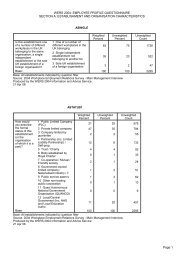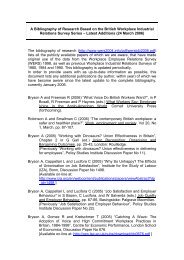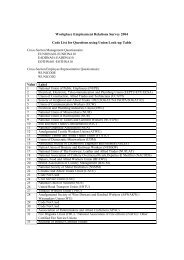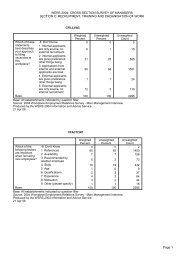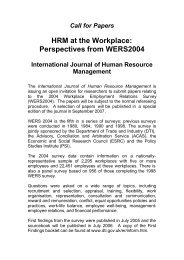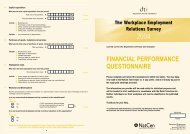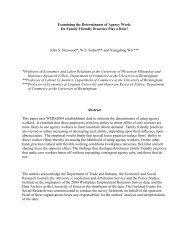A multilevel analysis of job satisfaction in Britain - WERS 2004
A multilevel analysis of job satisfaction in Britain - WERS 2004
A multilevel analysis of job satisfaction in Britain - WERS 2004
You also want an ePaper? Increase the reach of your titles
YUMPU automatically turns print PDFs into web optimized ePapers that Google loves.
‘overall’ as well as each <strong>of</strong> the ‘facet’ <strong>satisfaction</strong> variables with five categorieshas been collapsed <strong>in</strong>to a b<strong>in</strong>ary variable that assume a value one if an employeeis ‘very satisfied’ or ‘satisfied’ and zero otherwise. 9 Tables A1 and A2 <strong>in</strong> theAppendix report descriptive statistics and correlation matrix, respectively, <strong>of</strong> the<strong>satisfaction</strong> variables.A summary <strong>of</strong> the explanatory variables used <strong>in</strong> the empirical modell<strong>in</strong>g is alsogiven <strong>in</strong> Table A3 <strong>in</strong> the Appendix. These <strong>in</strong>clude: (i) employee-level correlatessuch as demographic and human capital characteristics, occupation, tenure, payas well correlates reflect<strong>in</strong>g employees’ assessment <strong>of</strong> the degree <strong>of</strong> <strong>job</strong>flexibility, <strong>job</strong>-level gender segregation and skill requirement <strong>of</strong> the <strong>job</strong>. (ii)workplace-level correlates such as establishment size, <strong>in</strong>dustry as well as othersperta<strong>in</strong><strong>in</strong>g to the level <strong>of</strong> gender-, age-, ethnic- and disability segregation at theworkplace.4. A framework <strong>of</strong> <strong>analysis</strong>Job <strong>satisfaction</strong>, or some aspect <strong>of</strong> it, is typically measured on an ord<strong>in</strong>al scale,requir<strong>in</strong>g the use <strong>of</strong> ordered probit or logit as the preferred econometricmodell<strong>in</strong>g strategy. This has led to the almost exclusive reliance on these models<strong>in</strong> the research <strong>in</strong>to the determ<strong>in</strong>ants <strong>of</strong> <strong>job</strong> <strong>satisfaction</strong> (e.g. Clark & Oswald1994, Blanchflower 1996, Sousa-Poza & Sousa-Poza 2000, Gazioglu et al. 2006,Maume & Sebastian 2007). The consequence <strong>of</strong> this heavy reliance on thesemodels, or at least their simpler versions, has been the <strong>in</strong>ability to account forunmeasured/unobserved heterogeneity, someth<strong>in</strong>g that may be regarded as adrawback <strong>of</strong> the exist<strong>in</strong>g literature on <strong>job</strong> <strong>satisfaction</strong>. 10Account<strong>in</strong>g for such unmeasured heterogeneity is particularly important <strong>in</strong> thecontext <strong>of</strong> a l<strong>in</strong>ked employer-employee data used <strong>in</strong> this paper for at least twoma<strong>in</strong> reasons. First, the variance <strong>of</strong> the estimated coefficients would beunderestimated, thereby lead<strong>in</strong>g to wrong <strong>in</strong>ference. Secondly, parameterestimates would be <strong>in</strong>consistent if the relationship between the outcome variable<strong>of</strong> <strong>in</strong>terest and the explanatory variables is non-l<strong>in</strong>ear (Rodriguez and Goldman,1995, 2001; Skrondal and Rabe-Hesketh, <strong>2004</strong>).As stated <strong>in</strong> the preced<strong>in</strong>g section, each <strong>of</strong> the orig<strong>in</strong>al ord<strong>in</strong>al <strong>satisfaction</strong>variables used <strong>in</strong> the empirical <strong>analysis</strong> <strong>in</strong> this study has been collapsed <strong>in</strong>to ab<strong>in</strong>ary variable that assumes a value one if ‘very satisfied’ or ‘satisfied’ and zerootherwise. 11 Thus, lett<strong>in</strong>g i <strong>in</strong>dex an employee, the underly<strong>in</strong>g cont<strong>in</strong>uous latent9 The advantages (& drawback!) that stem from this are expla<strong>in</strong>ed <strong>in</strong> the next section.10 There are few exceptions such as W<strong>in</strong>kelmann & W<strong>in</strong>kelmann (1998), Clark et al. (2006),Bryson et al. (<strong>2004</strong>, 2006)11 Although this approach raises the question <strong>of</strong> efficiency, not exploit<strong>in</strong>g all <strong>in</strong>formation <strong>in</strong> theorig<strong>in</strong>al <strong>satisfaction</strong> variable(s), it makes the <strong>multilevel</strong> modell<strong>in</strong>g much more tractable. That thisallows overcom<strong>in</strong>g problems <strong>of</strong> estimator <strong>in</strong>consistency stemm<strong>in</strong>g from the choice <strong>of</strong> break<strong>in</strong>gpo<strong>in</strong>t <strong>in</strong> the ordered probability models (Crouchley 1995) and possible misclassification problemsaris<strong>in</strong>g from self-reported measures <strong>of</strong> <strong>job</strong> <strong>satisfaction</strong> that Hausman et al. (1998) refer to aresome <strong>of</strong> the problems the approach used <strong>in</strong> this study m<strong>in</strong>imises.7



